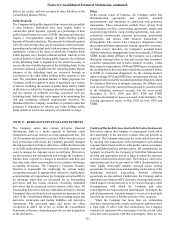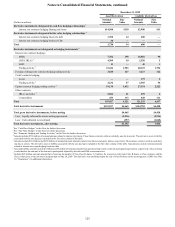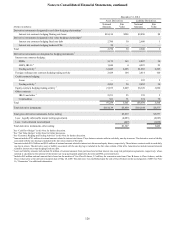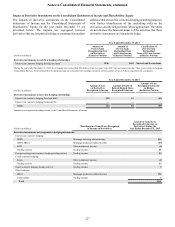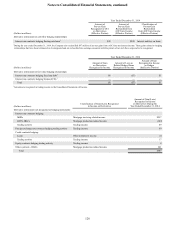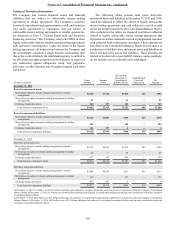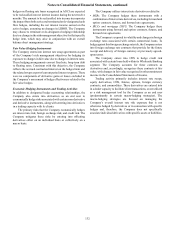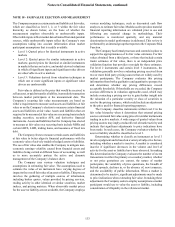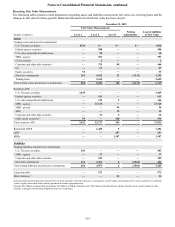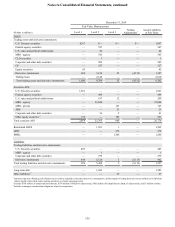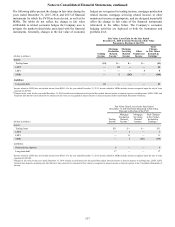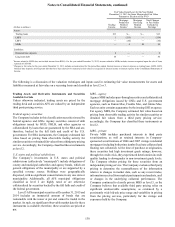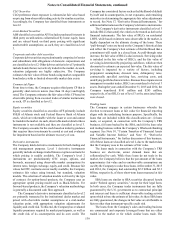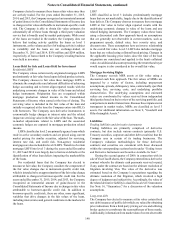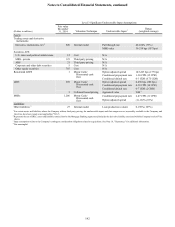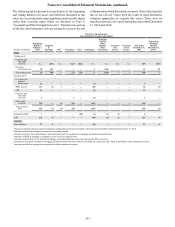SunTrust 2015 Annual Report Download - page 161
Download and view the complete annual report
Please find page 161 of the 2015 SunTrust annual report below. You can navigate through the pages in the report by either clicking on the pages listed below, or by using the keyword search tool below to find specific information within the annual report.Notes to Consolidated Financial Statements, continued
133
NOTE 18 - FAIR VALUE ELECTION AND MEASUREMENT
The Company measures certain assets and liabilities at fair value,
which are classified as level 1, 2, or 3 within the fair value
hierarchy, as shown below, on the basis of whether the
measurement employs observable or unobservable inputs.
Observable inputs reflect market data obtained from independent
sources, while unobservable inputs reflect the Company’s own
assumptions taking into account information about market
participant assumptions that is readily available.
• Level 1: Quoted prices for identical instruments in active
markets
• Level 2: Quoted prices for similar instruments in active
markets; quoted prices for identical or similar instruments
in markets that are not active; and model-derived valuations
in which all significant inputs and significant value drivers
are observable in active markets
• Level 3: Valuations derived from valuation techniques in
which one or more significant inputs or significant value
drivers are unobservable
Fair value is defined as the price that would be received to
sell an asset, or paid to transfer a liability, in an orderly transaction
between market participants at the measurement date. The
Company’s recurring fair value measurements are based on
either a requirement to measure such assets and liabilities at fair
value or on the Company’s election to measure certain financial
assets and liabilities at fair value. Assets and liabilities that are
required to be measured at fair value on a recurring basis include
trading securities, securities AFS, and derivative financial
instruments. Assets and liabilities that the Company has elected
to measure at fair value on a recurring basis include MSRs and
certain LHFS, LHFI, trading loans, and issuances of fixed rate
debt.
The Company elects to measure certain assets and liabilities
at fair value to better align its financial performance with the
economic value of actively traded or hedged assets or liabilities.
The use of fair value also enables the Company to mitigate non-
economic earnings volatility caused from financial assets and
liabilities being carried at different bases of accounting, as well
as to more accurately portray the active and dynamic
management of the Company’s balance sheet.
The Company uses various valuation techniques and
assumptions in estimating fair value. The assumptions used to
estimate the value of an instrument have varying degrees of
impact to the overall fair value of an asset or liability. This process
involves the gathering of multiple sources of information,
including broker quotes, values provided by pricing services,
trading activity in other identical or similar securities, market
indices, and pricing matrices. When observable market prices
for the asset or liability are not available, the Company employs
various modeling techniques, such as discounted cash flow
analyses, to estimate fair value. Models used to produce material
financial reporting information are validated prior to use and
following any material change in methodology. Their
performance is monitored quarterly, and any material
deterioration in model performance is addressed. This review is
performed by an internal group that reports to the Corporate Risk
Function.
The Company has formal processes and controls in place to
support the appropriateness of its fair value estimates. For fair
values obtained from a third party, or those that include certain
trader estimates of fair value, there is an independent price
validation function that provides oversight for these estimates.
For level 2 instruments and certain level 3 instruments, the
validation generally involves evaluating pricing received from
two or more third party pricing sources that are widely used by
market participants. The Company evaluates this pricing
information from both a qualitative and quantitative perspective
and determines whether any pricing differences exceed
acceptable thresholds. If thresholds are exceeded, the Company
assesses differences in valuation approaches used, which may
include contacting a pricing service to gain further insight into
the valuation of a particular security or class of securities to
resolve the pricing variance, which could include an adjustment
to the price used for financial reporting purposes.
The Company classifies instruments within level 2 in the
fair value hierarchy when it determines that external pricing
sources estimated fair value using prices for similar instruments
trading in active markets. A wide range of quoted values from
pricing sources may imply a reduced level of market activity and
indicate that significant adjustments to price indications have
been made. In such cases, the Company evaluates whether the
asset or liability should be classified as level 3.
Determining whether to classify an instrument as level 3
involves judgment and is based on a variety of subjective factors,
including whether a market is inactive. A market is considered
inactive if significant decreases in the volume and level of
activity for the asset or liability have been observed. In making
this determination the Company evaluates the number of recent
transactions in either the primary or secondary market, whether
or not price quotations are current, the nature of market
participants, the variability of price quotations, the breadth of
bid/ask spreads, declines in, or the absence of, new issuances,
and the availability of public information. When a market is
determined to be inactive, significant adjustments may be made
to price indications when estimating fair value. In making these
adjustments the Company seeks to employ assumptions a market
participant would use to value the asset or liability, including
consideration of illiquidity in the referenced market.


